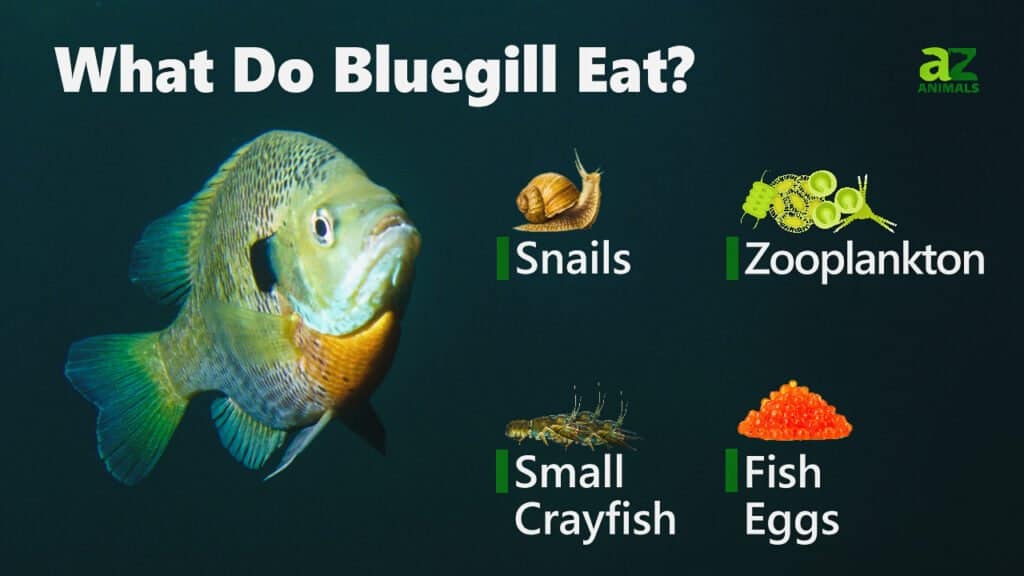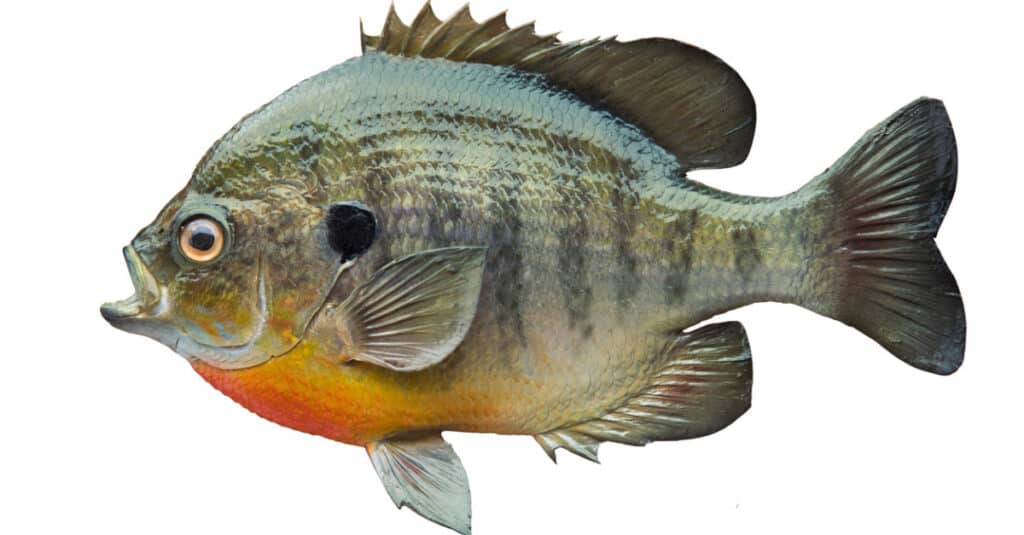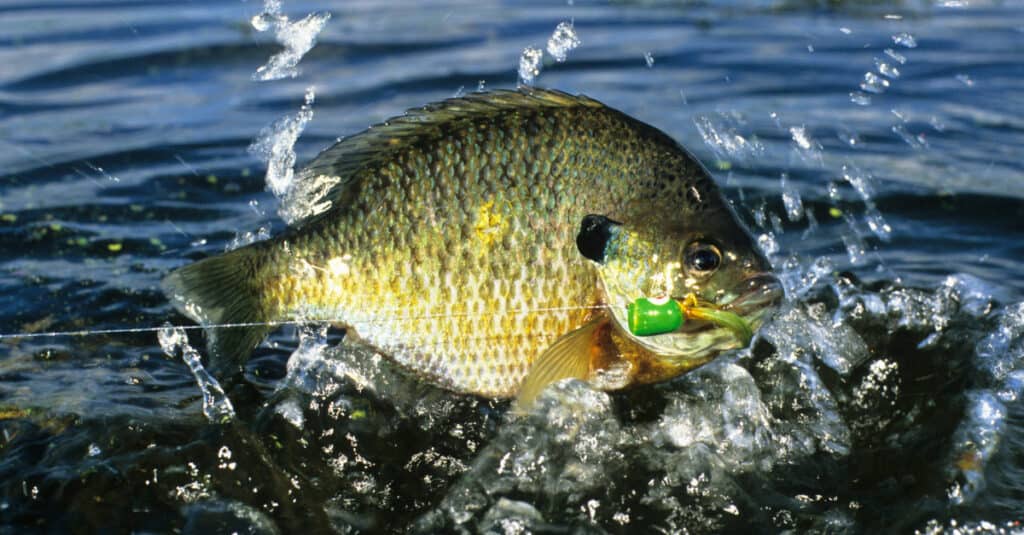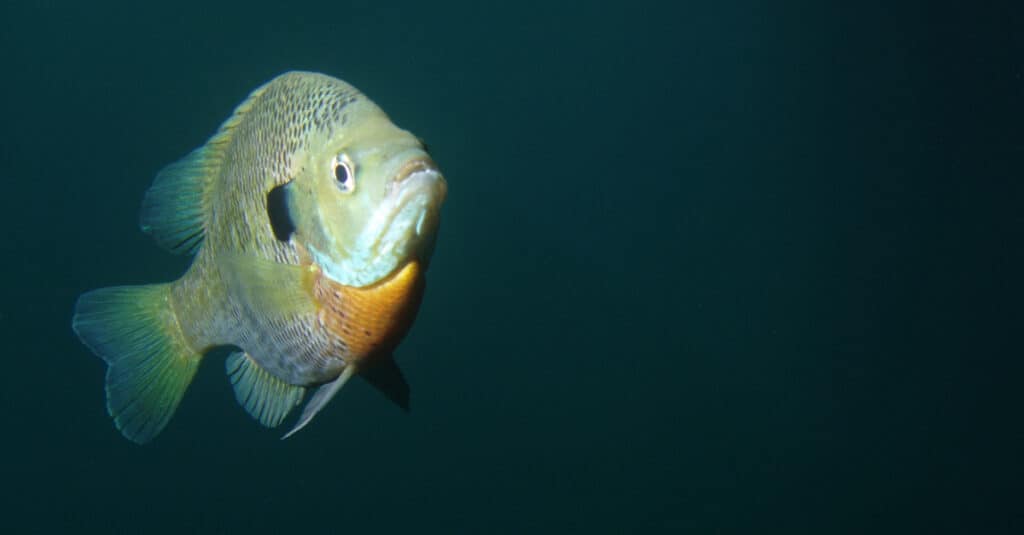The bluegill (Lepomis macrochirus) is a North American freshwater fish. The species is commonly referred to as copper nose, bream, sunny, or brim. They are the state fish of Illinois and are celebrated with an annual “Blue Gill Festival” in parts of Michigan.
Their natural range is east of the Rockies in the United States and Mexico. However, humans have introduced them to all other continents, and they have even adapted to saltwater in areas like the Chesapeake Bay. They are common in the State of Texas and are known locally as “perch.” Let’s dive into what bluegills eat!
The Diet of Bluegill Fish: What Do Bluegills Eat

Adult bluegills eat a wide variety of prey, including insects, larvae, shrimp, worms, and snails. They even consume smaller fish, such as minnows. Juvenile bluegills eat plankton, small crustaceans, and insects. If necessary, bluegill can tolerate algae and aquatic plants, and have even been known to eat their own eggs and offspring when desperate.
Depending on the habitat, bluegill often contain high levels of pollution due to their available diet and water conditions. Researchers often test local bluegill to determine the pollution levels of a certain area.
The bluegill is part of the Lepomis genus, which is home to related fish including:
- the redbreast sunfish
- the pumpkinseed
- the longest sunfish
- the northern sunfish
- the warmouth
- the bantam sunfish
- and many others!
In some parts of the world, bluegills are considered invasive species. They may take over the habitat of other fish species, or their populations can go unchecked if they have no natural predators. The fish is outlawed for trade in some countries, including Germany.
Bluegill are a popular target for anglers and are subject to recreational fishing limits and regulations. Many ponds and lakes around the United States are stocked with bluegill.
The average length of a bluegill is around 7.5 inches, with larger individuals reaching sizes up to 16 inches. They are short-lived, with the oldest reported specimen having been 10 years old.

Bluegills can grow to about 16 inches in length and can be voracious hunters in environments they’re introduced into.
©iStock.com/Willard
What Animals Eat Bluegill?
Given their worldwide distribution, bluegills have a wide variety of predators. The list includes catfish, walleye, trout, bass, and pike, as well as larger animals like otters, herons, and raccoons. Not to mention, humans are one of the most common bluegill predators. Through fishing, pollution, and habitat destruction, humans have the potential to wipe out entire populations of bluegills.
Can Humans Eat Bluegill?
Yes, humans can eat bluegill fish. The species is mild in taste and considered a table-quality fish. It is commonly cooked whole or fried. Bluegills are often fried in a pan, which inspired one of their nicknames: panfish.
While over-fishing can be a problem in some areas, bluegill are in no real threat as a species. They breed prolifically and can quickly replace depleted populations as needed.
How Do You Prepare Fresh Bluegill?

Fishing for bluegill is a popular activity around the United States.
©iStock.com/stammphoto
Bluegill can be prepared in a similar fashion to many other fish.
- First, the bluegill needs to be cleaned. Use a fish scaler or knife to scrape off the scales. Scrape from tail to head for maximum efficiency. When done properly, the skin should be smooth and free of all scales.
- Next, the head needs to be removed. Use a quality chef’s knife to chop the head just behind the gills.
- Gutting the fish is the messiest step. Slice the belly of the fish from head to tail and open it in a “butterfly” fashion. Remove and discard all of the internal organs.
- Chop off the tail and fins.
- Place a pan over medium-high heat. Add butter or oil and any other fixings that you choose. Place the bluegill in the pan for around five minutes on each side.
And voila! You have yourself a pan-fried bluegill. White sauces are often added to a bluegill, such as a lemon aioli or a sage cream sauce. Serve with roasted vegetables and a salad for a healthy, well-rounded meal.
What Size of Bluegill Can You Eat?

A lone bluegill considers its next move.
©iStock.com/Gant77
Bluegill in the 6 to 8-inch range are generally the best to eat. At this size, there is enough meat on the bone to make cleaning and cooking the fish worthwhile. Bigger specimens can be eaten as well, but they will contain higher concentrations of any pollutants that are present in the body of water. Additionally, releasing larger fish will allow other anglers to experience the joy of catching trophy bluegill.
Does Bluegill Taste Good?
Bluegill have a mild flavor and soft texture, making them an excellent choice of fish for those who can’t stand the “fishier” taste of other species. They are considered good for eating and their mild taste allows them to be infused with other flavors.
However, the taste of bluegill, or any fish, is subjective and opinions will range from person to person.
Thank you for reading! Have some feedback for us? Contact the AZ Animals editorial team.








